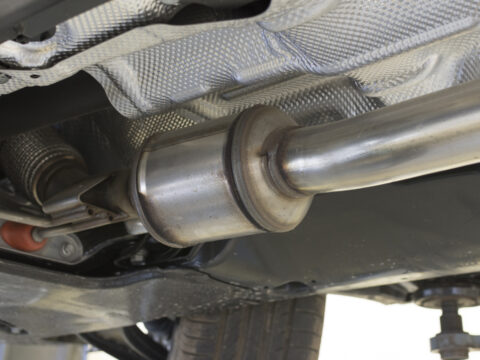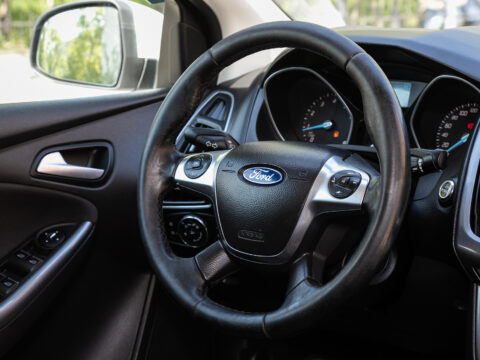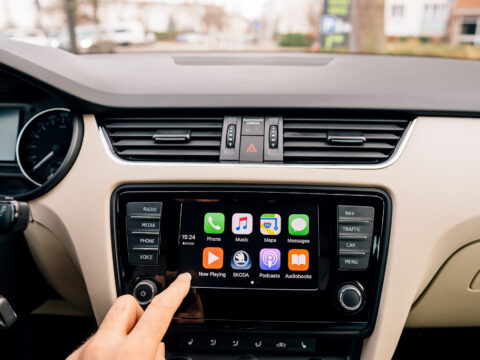Your vehicle can get as hot as 115 degrees Fahrenheit, so having working AC is crucial. If your ambient temperature sensor has been giving your Ford problems, we’re here to help.
Resetting the sensor is as easy as locating and disconnecting the dial and twisting the sensor. Read on to learn the specific details to test and replace the component should it become necessary.

Contents
What Is an Ambient Temperature Sensor?
To start with, what is your ambient temperature sensor? As the name implies, this component is responsible for sensing the temperatures around it.
Working as a crucial component for your air conditioning system, the ambient air temperature sensor informs your vehicle of temperatures. Doing so helps to display the temperature outside in your information displays.
More importantly, it also helps your air conditioning regulate the temperature. If you’re using the automatic temperature controls, you’ll have your ambient temperature sensor to thank.
If your ambient temperature sensor is faulty, it can display incorrect temperatures or weather. It also can cause your automatic temperature to fail to come on, as it senses a temperature that won’t require it to function.
Because of this, a faulty ambient temperature sensor can remove several features of your vehicle. It’s easy to see why you’d want this issue fixed as quickly as possible!
Where Is the Ambient Temperature Sensor Located on a Ford?
The location of the ambient temperature sensor depends on the make, model, and year of your vehicle. Some air temperature sensors are located inside or near the front bumper, which is the most common place to find them. You will not find the component inside the passenger cabin.
Symptoms of a Bad Ambient Temperature Sensor
Now that we know what the ambient temperature sensor is and its functions, how do we know when it’s faulty? Here are some of the most common symptoms of a faulty ambient temperature sensor.
Faulty Automatic Mode
One of the most common ways to recognize the issue is a faulty automatic mode. As your vehicle fails to read the ambient air temperature, it doesn’t know when to activate properly.
Inconsistent Cooling
In the same vein, you may find your automatic temperature working intermittently and inconsistently. Your air may come on for a few minutes before shutting itself off again.
If you’re not using automatic controls, you may never notice this. Using manual controls will often override this issue. If you’re failing to get proper air without the setting, you may have something else wrong with your cooling systems.
Incorrect Outdoor Temperature Readings
As the ambient temperature sensor also keeps track of the outdoor temperature, faulty sensors may show an incorrect temperature. You may get into your vehicle on a scorching day and find the temperature displayed as much lower than is accurate.
This rarely feels like a problem, as you usually don’t rely on your vehicle for the weather. Still, it’s important information in many situations and is a sign that something’s gone wrong. Make sure your sensor is working to restore this functionality.
No Cooling
If your sensor is faulty, it may fail to cool anything. This is usually only detectable if you use the automatic air conditioning mode. If your air is fully non-functional, you may have more severe issues than a faulty ambient temperature sensor.

How Do You Reset the Ambient Temperature Sensor on a Ford?
Now that we know what the ambient temperature sensor is responsible for, knowing how to fix it is crucial. Thankfully, this fix is usually simple, so many automotive enthusiasts can complete it by themselves.
That said, don’t hesitate to get professional help. They can ensure that it’s done quickly and correctly. This will also ensure your safety and usually isn’t costly. Most importantly, they can also diagnose if the issue with your air is the sensor or if you have other problems.
Tools and Equipment Needed
The ambient temperature sensor isn’t difficult to remove, making it so you won’t need many tools. Most often, you can find the temperature sensor near the top of the engine, so you won’t need to lift your vehicle. Get a socket wrench and a screwdriver, as well as your safety gear.
Turn Off or Disconnect the Battery
The first step when working with the electronics in your vehicle is to turn off the vehicle. You should also disconnect the battery to ensure you aren’t shocked.
Locate the Ambient Temperature Sensor
Once your vehicle isn’t powered, you’ll need to locate your ambient temperature sensor. On most models, you can find this at the top of the engine. Follow the AC hoses behind the radiator and towards the front of your vehicle’s bumper. It should look like a small cap above an electrical connection.
Disconnect the Sensor’s Wiring
Once you’ve located the compressor, you’ll need to disconnect it. Use your screwdriver to remove the cover that you see and reveal the sensor. Afterward, hold down the locking tab on the back side of the connector.
Doing so will disconnect the electric wiring from your ambient air temperature sensor. Pull the wire out from the connection to successfully disconnect your sensor. Next, pull the second connector away while holding the release tab to fully complete the disconnection.
As a note, do not disconnect anything you can’t reliably identify. Poking around with components you don’t understand can lead to damage and injury.
Adjust Dials
Once you have your module, twist the sensor dial clockwise to set it to the maximum. Reconnect the device afterward, turning left (counterclockwise) until you hear a click.
Lock the Sensor In Place and Reconnect
Push the connectors back into place and ensure that they’re locked in. Twist each connector counterclockwise to lock it into place once again. Afterward, replace the ambient temperature sensor cover that you removed with the screwdriver.
To do so, line up the cap’s mounting studs with their respective holes. Then, tighten the locking ring to help keep everything in place. Once you’ve completed these steps, reconnect your battery and turn your car back on to test the air.
How Do You Test an Ambient Temperature Sensor?
The easiest way to test an ambient temperature sensor is to leave your air on the automatic setting and let the air come on or off. If it performs as expected, it shouldn’t have any issues.
The normal ambient temperature is 68 – 72 degrees Fahrenheit. Your automatic air likely won’t come on outside of this bull’s-eye zone.
Another way is to purposefully alter the temperature of your ambient temperature sensor. One trick is to use a hair dryer to heat the component, tricking it into thinking it’s warmer than it truly is. Doing so should cause it to turn your air on to cool back down. If it fails to do so, you can often safely assume it’s faulty.
Past this, some mechanics have machinery that can more accurately test the sensor. Consider bringing your vehicle in for repairs to see if the ambient temperature sensor is an issue.
Ford Ambient Temperature Sensor Price and Replacement Cost
Thankfully, it isn’t too expensive to replace an ambient air temperature sensor as compared to other components. However, you should expect the price to change depending on your vehicle’s year and model.
For a more modern vehicle, you should expect about $200-$300 to repair or replace the filter. Other older vehicles usually cost $75-$150, depending on the year and severity of the damage.
Staying Cool
Your ambient air temperature sensor will help to maintain temperatures and display environmental information. If the sensor is broken, you’ll lose functionality and can have a more uncomfortable commuting experience. Follow the steps above to test or replace your sensor or consider bringing it to a mechanic for full repairs.
For more information on your automotive gadgetry, be sure to browse the rest of our site!














